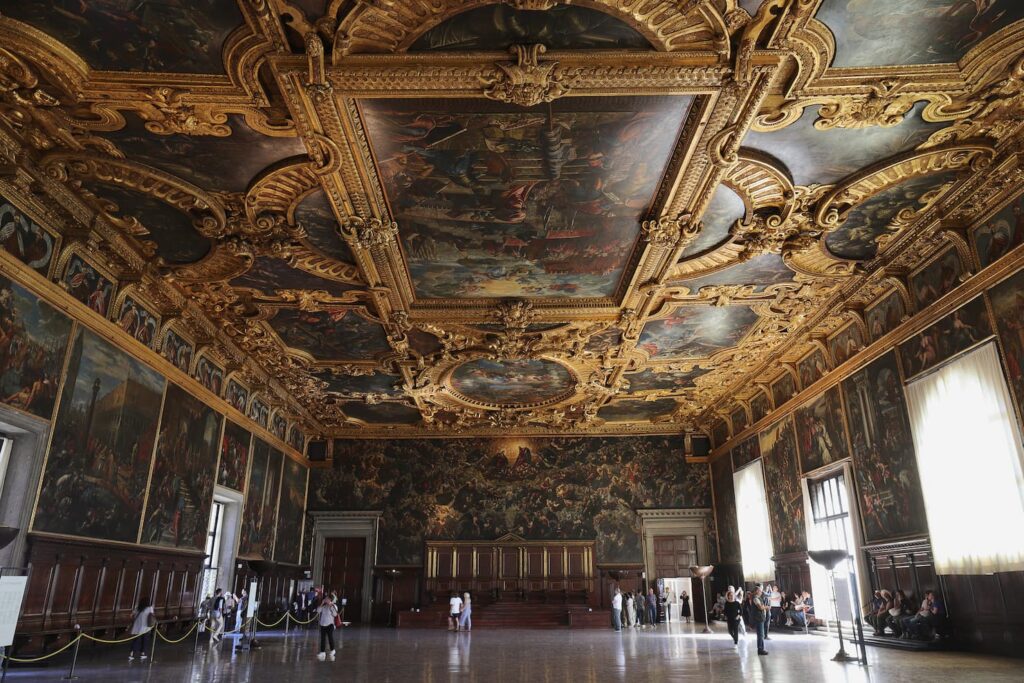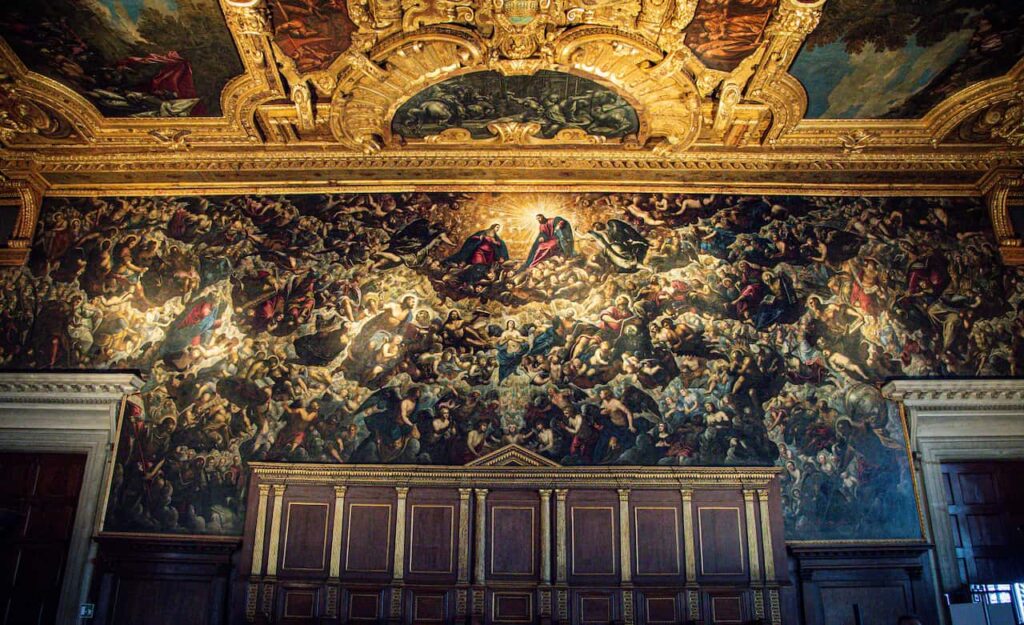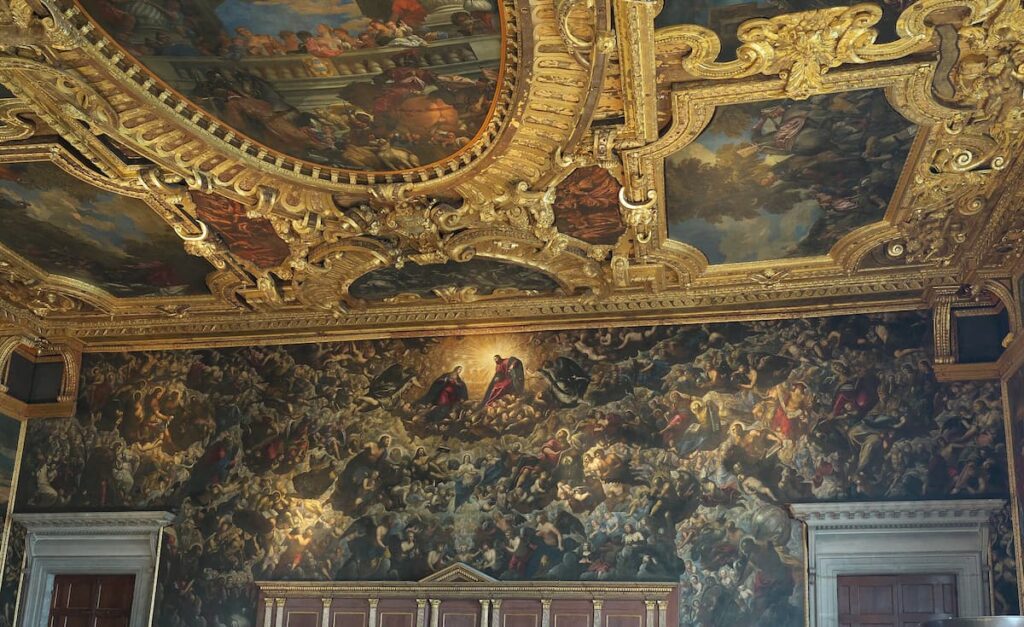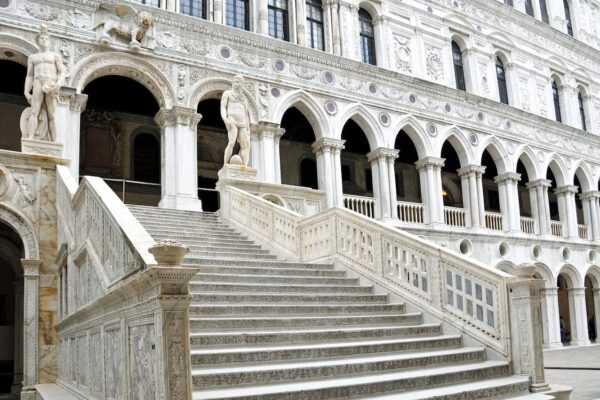This enormous painting, created by Tintoretto between 1588 and 1599, is located at the end of the Hall of the Great Council in the Doge’s Palace in Venice.
Before we begin, a brief preamble: if you plan to visit the Paradise and all of Tintoretto’s works in the Doge’s Palace in Venice, it is strongly recommended that you buy your ticket online, due to the long queue that may form at the ticket office. By purchasing your ticket in advance, you will be able to enter the Palace by skipping the queue.

Doge’s Palace Venice skip-the-line ticket: quick access
Buy online. Choose your preferred time. Visit the Doge’s Palace of Venice, the Hall of Great Council, the prisons and more.
You can cancel for free up to the day before your visit.
Tintoretto’s Paradise: description and analysis

The work representing Il Paradiso (Paradise) consists of several sewn canvases in which around five hundred figures including saints and angels were painted.
At first glance, the vision of the painting is unexpectedly chaotic and crowded, almost gloomy, were it not for the light that pervades the two main characters of the scene, Jesus and Mary, supported by a large number of cherubs and seraphim. The beam of light that descends below them is the representation of the holy spirit, which falls on the tympanum of the doge’s throne and announces Christ’s favours for the Republic.
Tintoretto liked to convey a sense of pathos and drama in his works, using representational modes such as chiaroscuro with bold contrasts and daring perspectives.

The subject matter is not only religious, but also an allegory of good governance. Light is the divine essence that enters into the figure of the doge, who has a heavenly mission that enables him to always make the best decisions.
Numerous characters can be identified by their symbols in the painting:
Mary receives a flower from an angel in flight and the Archangel Gabriel brings her the Annunciation Lily. The four evangelists are depicted below the main characters: St Mark is represented with the Lion, Luke is accompanied by the Ox, Matthew is represented with the Angel and John is represented with the Eagle. The twelve apostles, Adam and Eve, Abraham and his son Isaac, King David playing the psaltery and Moses with the tablets of the law are all represented on the right.
The prophets and doctors of the church can be identified when the books are opened; the martyrs are depicted in considerable numbers with palms in hand.
The painter, no longer young, collaborated with his son Domenico to create the painting, which Ruskin called “the most beautiful in the history of art”.
Jacopo Tintoretto’s Paradise: details
- Author: Jacopo Robusti (known as Il Tintoretto)
- Date: 1588-1592
- Location: Hall of the Great Council
- Dimensions: 765 x 2451 cm
- Technique: Oil on canvas
Who was Il Tintoretto?
Jacopo Robusti, also known as ‘Il Tintoretto’, was born in Venice in 1518 and was one of the leading masters of the Venetian school and the Italian Renaissance.
The appellation Tintoretto came from his father’s profession as a fabric dyer, who cultivated his artistic skills by having him study at the workshop of the painter Titian.

Doge’s Palace Venice skip-the-line ticket: quick access
Buy online. Choose your preferred time. Visit the Doge’s Palace of Venice, the Hall of Great Council, the prisons and more.
You can cancel for free up to the day before your visit.
Photo credits:
- Sala del Maggior Consiglio: Photo by Michael Kemper via Flickr
- Il Paradiso di Tintoretto: Photo by CdeHaan via Flickr
- Salone del Maggior Consiglio: Photo by David Abrantes via Flickr


